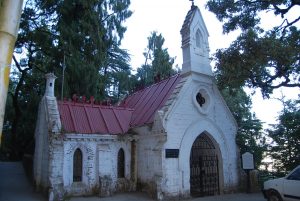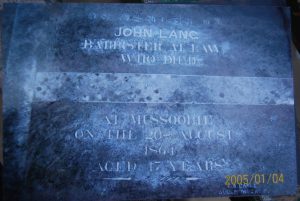The first of all Mowgli published stories so far
Raju Gusain: A eight year girl, now dubbed as Mowgli girl, was found recently in jungles of Katraniyaghat in Bahraich of Uttar Pradesh. The girl was found living with a troop of monkeys and behaving like animals-not speaking and walking like human. The Mowgli girl forced people to remember the famous literary piece of Nobel laureate Rudyard Kipling, The Jungle Book.
Though The Jungle Book got published in 1894, but a story with similar storyline and which got published in England 164 year back possibly inspired Kipling to pen his famous book. Even that story was also written on the backdrop of a place in Uttar Pradesh.
The connection of the story written by writer, novelist, journalist and barrister John Lang- which got published in 1853- and the newspaper with whom Rudyard worked indicate some relationship.
John Lang is more remembered in India for fighting legal case of Rani Laxmibai against British empire for annexing her estate. Lang started a newspaper, The Mofussilite, in India in 1845 from Kolkata and later moved it to north India. The Mofussilite shifted its base in different cities including Ambala, Agra, Meerut and Delhi. After the death of John Lang, his newspaper became a part of the Civil and Military Gazette in Lahore. Incidentally, Rudyard Kipling was associated with Civil and Military Gazette and began his journalism career with this newspaper in 1882.
The year 1853 witnessed a story like that of Mowgli thrilling readers. John Lang’s small story got published in Household Words, an English weekly magazine edited by Charles Dickens in the 1850s. The story titled ’Wolf Nurses’ appeared in the 26 February 1853 issue of Household Words and presented a fascinating tale from Oude- now known as Awadh (Uttar Pradesh).
The story starts by presenting a grave problem of Oudh, “In the Kingdom of Oude, some ten years ago, a male child of about eighteen months old was missed by its parents. It was supposed to have been carried away and devoured by the wolves, which are very plentiful in that part of the world. Every winter numbers of children are destroyed by these animals, not only in Oude, but in our own provinces in the north-west.”
And making narration of the find the story John Lang writes, “About seven years after the child was missing, a man who gained his livelihood by shooting in the jungles saw a wolf and several cubs, and with them an animal such as he had never seen before. It was like a boy, but ran upon all fours. The man followed the animal, but was unable to keep pace with it; he traced it, however, to a den, and a few days after words succeeded in taking the animal alive. It barked, or rather snarled and growled like a wolf, and attempted to bite its captor. The she-wolf and her cubs followed the man for some distance, and several times showed symptoms of a desire to rescue the animal; but, as the man was armed, they did not venture to attack him, and at last they returned to the jungle.”
John Lang got this piece published in 1853 and Rudyard Kipling penned story with similar outline in 1894. Both the writers were closely associated with India and Himalayas. After staying in many Indian cities, Lang finally settled in Mussoorie and died here on 20 August 1864. Lang is buried at the Camel’s Back graveyard in Mussoorie. Kipling wrote many stories on hill life, including ‘Plain tale from the hills.’
Lang got this piece published in 1853 and Rudyard Kipling penned story with similar outline in 1894. Both the writers were closely associated with India and Himalayas. After staying in many Indian cities, Lang finally settled in Mussoorie and died here on 20 August 1864. Lang is buried at the Camel’s Back graveyard in Mussoorie. Kipling wrote many stories on hill life, including ‘Plain tale from the hills.’
He came once in Mussoorie, stating this historian Gopal Bhardwaj says, “Kipling came in 1880s and stayed at the Charleville Hotel for one week. Even in his book Kim there are references about Mussoorie. The Charleville Hotel no longer exits and the building is now a part of the Lal Bahadur Shastri National Academy of Administration.”
John Lang used to reprint most of his literary work, which he used to get publish abroad, in his newspaper. Though no accurate information about Wolf Nurses, getting published in The Mofussilite, is available, but alike his other stories this too must have got printed in the newspaper.
Mussoorie’s legendary resident, writer Ruskin Bond claims, “The Mofussilite was one of the most popular newspapers of north India at that time.”
The Mofussilite was popular among its readers- as it used to make fun of the British and because of variation in news coverage and for gossip. The periodical began its journey on 2 August 1845 from Kolkata- before moving to north India in 1846. Lang shifted his base first to Ambala and later to Meerut, Agra and Delhi.
From 2 August 1845 to 22 November 1845, The Mofussilite was a weekly newspaper and turned bi-weekly from 1 January 1847 to 9 July 1867 and increased its print frequency- by getting printed three times a week-from 16 July 1867 to 27 April 1872.
As Civil and Military Gazette took ownership of The Mofussilite in later period, there is possibility of Kipling had some access of Lang’s work. In 1876, the Mofussilite newspaper shifted its base for the last time and S.M.A. Feroze writes in Press in Pakistan (1957), “The Mofussilite was incorporated in the Civil and Military Gazette in 1876 when the latter resumed its publication as a daily from Lahore.”
John Lang created headlines again in 2014. This time due to Prime Minister Narendra Modi for presenting Australian PM Tony Abbott, a commemorative photo collage dedicated to the memory of John Lang, an Australian with a remarkable Indian connection.
Lang created headlines again in 2014. This time due to Prime Minister Narendra Modi for presenting Australian PM Tony Abbott, a commemorative photo collage dedicated to the memory of John Lang, an Australian with a remarkable Indian connection.
Interestingly , the archival copies of The Mofussilite is not available in any Indian library- including at the National Library in Kolkatta. But, its copies are available in the National Archives of Pakistan.
, the archival copies of The Mofussilite is not available in any Indian library- including at the National Library in Kolkatta. But, its copies are available in the National Archives of Pakistan.
The Bahraich girl incident has provided a chance to remember John Lang, who possibly published first of any Mowgli story published ever. That too 164 year back!
Photo: Grave of John Lang in Mussoorie
Photo: The main gate of the Camel’s Back Road Cemetery in Mussoorie
Photo: Sketch of writer and Barrister John Lang
Photo: Masthead of ‘The Mofussilite’ newspaper